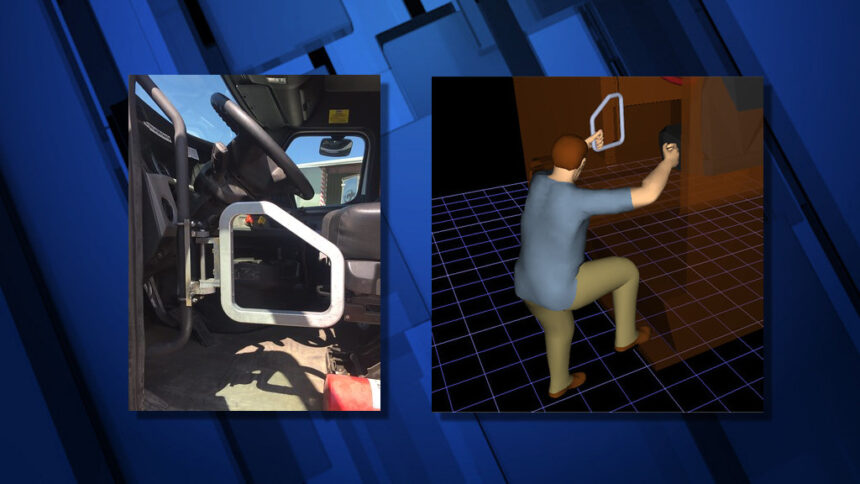Daimler-commissioned safety feature prototype gets glowing reviews

A new safety feature may soon be making an appearance on trucks across the nation thanks to this new handle intended to aid truckers in entering and exiting their cab.
Students at the Oregon State University College of Engineering have designed an aftermarket device that, once installed, gives truck drivers something to hold onto while climbing into and out of their rig.
Daimler Trucks North America approached the university with the idea for the project back in September 2019, and the students delivered. After testing the efficacy of several designs, the students landed on a five-sided handle that is roughly two-thirds the size of a truck steering wheel. The device is designed to be mounted underneath the instrument panel between the driver and the door, and is locked in a position parallel to the cab door when the driver is inside. When the driver is ready to exit, they must simply release the handle and swing it outward, similar to the way the cab door opens. To enter the cab and close the door, the driver would simply swing the handle inward, back to its position parallel to the door, and lock it back in place.
“I am extremely happy with the results of the project and the approach taken by the students…” said Kary Schaefer, general manager of product marketing and strategy for Daimler Trucks North America.
“It was great to work with the team and be part of the progress. They took a very complex and important problem, with many potential root causes and scenarios for solutions, broke it down into its basic elements and came up with a design that is simple and cost effective. Slip-and-fall accidents are a challenge for fleet operators and truck manufacturers because it takes a combo of design, training and changing driver habits. This solution ticks all of those boxes.”
While not a replacement for the standard “three-points-of-contact” training, this handle provides a supplemental aspect to the safety policy.
“The lack of a mechanical device such as this one being developed has left a gap [in the three-points-of-contact training,]” said Ken Zelenka, operations manager at a trucking company currently testing the prototype. “Currently a driver could bale, swing or jump out of a cab face first and while doing so put themselves at risk for injury. While we’d like to believe that doesn’t happen, the fact is that it likely does as we do continue to see injuries related to getting in and out of cabs.”
As part of the student’s research, drivers at Gardner Trucking in Albany, Oregon were interviewed, and are even in the process of field-testing the new invention. Gardner is part of CRST International based in Cedar Rapids, Iowa.
“The prototype has been very well received,” said Ken Zelenka, Gardner’s operations manager. “We’re excited to have been a part of the process thus far and are looking forward to continued participation on this project. Slips, trips and falls have been a concern in our industry for decades and are something we’ve worked hard to contain.”
“It’s simple to use,” Zelenka continued. “I’ve used it myself during the teams’ site visits. It requires very little effort; we believe drivers would quickly acclimate to its use.”
“Future work will optimize the design for mass manufacturing, and the project will finish with a manufacturing plan being delivered to Daimler for mass production and implementation,” said Arthur Wells, a master’s student in mechanical engineering at the university who led the project.
“All OSU had to start with was that truck drivers are being hurt getting into and out of their cabs, so this project will go through an entire product development cycle, all the way to a product launch.”